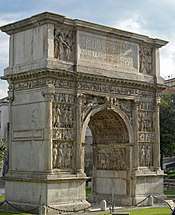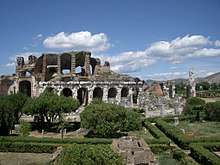Pozzuoli
Pozzuoli (Italian pronunciation: [potˈtswɔːli]; Latin: Puteoli) is a city and comune of the Metropolitan City of Naples, in the Italian region of Campania. It is the main city of the Phlegrean Peninsula.
Pozzuoli | |
|---|---|
Panorama of Pozzuoli | |
 Coat of arms | |
Location of Pozzuoli 
| |
 Pozzuoli Location of Pozzuoli in Campania  Pozzuoli Pozzuoli (Campania) | |
| Coordinates: 40°50′40″N 14°05′36″E | |
| Country | Italy |
| Region | Campania |
| Metropolitan city | Naples (NA) |
| Frazioni | Arco Felice, Campana Annunziata, Cuma, Licola Centro, Licola Lido, Lucrino, Montenuovo, Monterusciello, Pisciarelli, Toiano |
| Government | |
| • Mayor | Vincenzo Figliolia (PD) |
| Area | |
| • Total | 43.44 km2 (16.77 sq mi) |
| Elevation | 28 m (92 ft) |
| Population (31 August 2017)[2] | |
| • Total | 81,231 |
| • Density | 1,900/km2 (4,800/sq mi) |
| Demonym(s) | Puteolani |
| Time zone | UTC+1 (CET) |
| • Summer (DST) | UTC+2 (CEST) |
| Postal code | 80078, 80014, 80125 |
| Dialing code | 081 |
| Patron saint | St. Proculus |
| Saint day | November 16 |
| Website | Official website |
History
Pozzuoli began as the Greek colony of Dicaearchia (Greek: Δικαιαρχία). The Roman colony, established in 194 BC, took the name Puteoli whose roots are in the Latin puteus (well or cistern) and Oscan fistulus (quarry).[3] An alternative etymology of Puteoli derives from the Latin puteo (to stink), referring to the sulfuric fumes in the area, most notably from Solfatara.[4] Pozzuoli itself lies in the centre of the Campi Flegrei, a volcanic caldera.
Puteoli was the great emporium for the Alexandrian grain ships, and other ships from all over the Roman world. It also was the main hub for goods exported from Campania, including blown glass, mosaics, wrought iron, and marble. The Roman naval base at nearby Misenum housed the largest naval fleet in the ancient world. It was also the site of the Roman Dictator Sulla's country villa and the place where he died in 78 BC. Pliny mentions Pozzuoli as the site of a famed cochlearium created by Fulvius Hirpinus, known for raising exquisite snails.
The local volcanic sand, pozzolana (Latin: pulvis puteolanus, "dust of Puteoli") formed the basis for the first effective concrete, as it reacted chemically with water. Instead of just evaporating slowly off, the water would turn this sand/lime mix into a mortar strong enough to bind lumps of aggregate into a load-bearing unit. This made possible the cupola of the Pantheon, which is still the world's largest unreinforced concrete dome.
_-2.jpg)
The apostle Paul landed here on his way to Rome, from which it was 170 miles (274 kilometres) distant. Here he stayed for seven days (Acts 28:13, 14) and then began with his companions his journey by the Appian Way to Rome.
Puteoli is considered the best candidate for the unnamed city where the 1st-century Roman novel Satyricon takes place.
In 37 AD Puteoli was the location for a political stunt by Emperor Gaius Caligula, who on becoming Emperor ordered a temporary floating bridge to be built using trading vessels, stretching for over two miles (3.2 km) from the town to the famous neighboring resort of Baiae, across which he proceeded to ride his horse, in defiance of an astrologer's prediction that he had "no more chance of becoming Emperor than of riding a horse across the Gulf of Baiae".[5]
Saint Proculus (San Procolo) was martyred here with his companions in the fourth century, and is the city's patron saint. The seven eagle heads on the coat-of-arms for the town of Pozzuoli are said to represent seven of these martyrs. November 16 was the official feast day for Saint Proculus. St. Proculus was affectionately nicknamed 'u pisciasotto ("the pants-pisser") because November 16 was often a day of rain. The townspeople also celebrated his feast day on the second Sunday in May.[6]
Charles Lyell visited Pozzuoli in 1828 and studied the Macellum columns.
Since 1946 the town has been the home of the Accademia Aeronautica, the Italian Air Force Academy, which was first situated on the island of Nisida, then from 1962 on a purpose-built hilltop campus overlooking the bay.
From August 1982 to December 1984 the city experienced hundreds of tremors and bradyseismic activity which reached a peak on October 4, 1983, damaging 8,000 buildings in the city center and dislocating 36,000 people, many permanently. The events raised the sea bottom by almost 2 m, and rendered the Bay of Pozzuoli too shallow for large craft.
Main sights

The town's attractions include:
- The Macellum of Pozzuoli, also known as the Temple of Serapis or serapeum, is considered the city's symbol. The "temple" was actually a marketplace. Its name derives from the misinterpretation of its function after a statue of the god Serapis was found in 1750 at this location. The Macellum includes three majestic columns in Cipollino marble, which show erosion from marine Lithophaga molluscs when, at an earlier time, the ground level was much lower due to Bradyseism, and sea-water could flow in.[7]
- Flavian Amphitheater (Amphitheatrum Flavium), the third largest Italian amphitheater after the Colosseum and the Capuan Amphitheater.
- Solfatara (volcanic crater with active fumaroles)
- Forum
- Minor Amphitheater, very near to the Flavian one, its remains were absorbed by other buildings, but some arches can be seen by Via Solfatara and Via Vigna. It is crossed by metropolitan railway and the arena is still buried
- Puteoli's Baths, so called Temple of Neptune, the remains of a big thermal complex now in Corso Terracciano which included also "Dianae Nymphaeum", this last one partly hidden by buildings.
- Villa Avellino, one of the few urban parks of Pozzuoli. It also shows several Roman ruins and water tanks. There is also a still working Roman "face" water fountain.
- Rione Terra, the first settlement of Puteoli, originally Dicearkia in Greek. It is a multi-layered city with several Roman buildings; the most important one is the Temple of Augustus (today the Pozzuoli's Duomo)
- Necropolis of the Via Puteolis Capuam, just under the bridge that leads outside the city near Via Solfatara
- Necropolis of Via San Vito, near to Quarto
- Necropolis of Via Celle, a rich complex of tombs and mausoleums, very near to an old Roman street track still used today (Via Cupa Cigliano)
- Stadium of Antoninus Pius, a very similar stadium to the Domitian one in Rome, only partially unburied and partly collapsed (Via Campi Flegrei).
- Sanctuary of San Gennaro (St. Januarius). With the Cathedral of Naples, it is one of the two places in which the alleged miracle of the liquefaction of the saint's blood occurs.
- Acropolis of ancient city of Cumae
- Lake Avernus, in which Virgil, in the 6th book of his Aeneid, placed the entrance to Hell. The name derives from Greek, and means "Without Birds", referring to the absence of birds due to the sulfur gas that sprung from it. Nearby are the Temple of Apollo, the Grotto of the Cumaean Sibyl and Cocceius' Grotto, a gallery carved by the Romans to connect Lucrino to Cumae. The latter was damaged during World War II and is no longer visitable.
- Lake Lucrino, in the frazione of the same name. The lake was considered an infernal place, due to volcanic phenomena. It was a renowned resort in Roman times and included the villa of Cicero, which later held the remains of emperor Hadrian. Pliny the Elder cites it in Naturalis historia (ix, 25) as the home of a dolphin who had made friends with a child. According to Pliny, when the child fell ill and died, the dolphin died of broken heart also. The tale is considered the first known Urban legend.
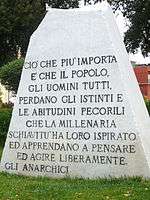
A unique anarchist monument is present in the small garden close to the Roman Macellum. It's made of a marble block and has the following text written on it:
Italian: Ciò che più importa è che il popolo, gli uomini tutti, perdano gli istinti e le abitudini pecorili che la millenaria schiavitù ha loro ispirato ed apprendano a pensare ed agire liberamente. Gli anarchici. English: What matters most is that people, all men, lose their sheepish instincts and habits that longstanding slavery has inspired in them, and they learn to think and act freely. The anarchists.
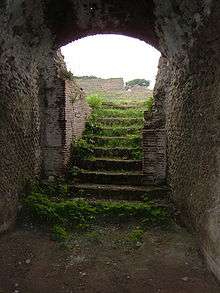
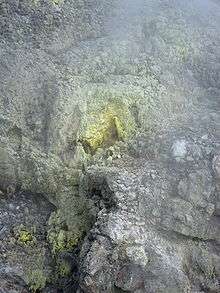
Transportation
It is easily reached by train from Rome on Naples Metro line 2, and by the trains of "Cumana" lines leaving from the station of Montesanto, in the city center.
Twinnings

Neighboring communes
Notable people
- Januarius, Patron Saint of Naples, executed at Solfatara c. 305
- Josephus landed there on his way to Rome (The Life of Flavius Josephus; 3.16)
- William Jopling, British leprologist, born there
- Sophia Loren, film actress, grew up there
- Gilbert, Count of Montpensier, Viceroy of Naples died there on 15 October 1496
- Saint Paul, the Apostle landed there on his way to Rome. (Acts 28:13)
- Giovanni Battista Pergolesi, Baroque composer, died there
- Lucius Cornelius Sulla, Dictator of Rome, died at his villa there
- Ludovica Nasti, “L’amica geniale”/“My Brilliant Friend” actress, originally from there
See also
Footnotes
- "Superficie di Comuni Province e Regioni italiane al 9 ottobre 2011". Istat. Retrieved 16 March 2019.
- "Popolazione Residente al 1° Gennaio 2018". Istat. Retrieved 16 March 2019.
- "Comune di Pozzuoli (NA)".
- John Everett-Heath, ed. (2010). "Pozzuoli". Concise Dictionary of World Place-Names. Oxford University Press (Oxford Reference Online Premium Database).
- C. Suetonius Tranquillius. "Caius Caesar Caligula." The Lives of the Twelve Caesars.
- http://www.icampiflegrei.it/Azienda%20Turismo/pozzuoli/articoli2003/novembre_eng.htm
- Legler, Rolf (1990). Der Golf von Neapel (in German). Cologne: DuMont Buchverlag. ISBN 978-3-7701-2254-7.
Bibliography
- Amalfitano, Paolo, et al. (1990) I Campi Flegrei, Venezia
- Annecchino, Raimondo (1960) Storia di Pozzuoli e della zona flegrea. Pozzuoli: Arti Grafiche D. Conte
- Gianfrotta, Piero Alfredo & Maniscalco, Fabio (eds.) (1998) Forma Maris: Forum Internazionale di Archeologia Subacquea. Puteoli
- Gore, Rick (May 1984). "A Prayer For Pozzuoli". National Geographic. Vol. 165 no. 5. pp. 614–625. ISSN 0027-9358. OCLC 643483454.
- Puteoli: studi di storia Romana; no. 2; 4/5
- Sommella, Paolo (1978) Forma e urbanistica di Pozzuoli romana. Pozzuoli: Azienda Autonoma di Soggiorno, Cura e Turismo di Pozzuoli
- Atti del convegno Studi e ricerche su Puteoli romana: Napoli, Centre J. Bérard, 2-3 aprile 1979. Napoli, 1984
